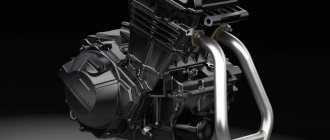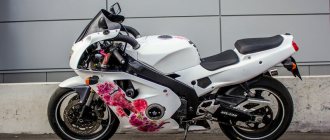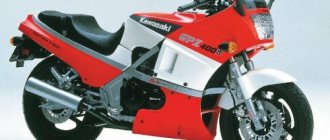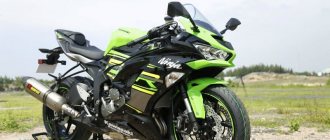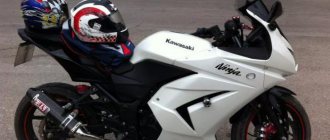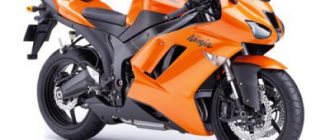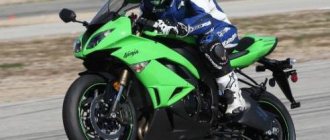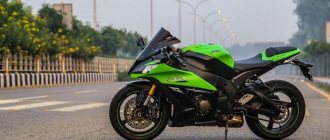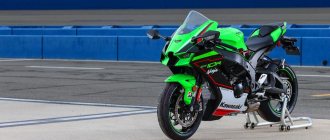| Kawasaki ER-4N (2010-2013) | Kawasaki Ninja 400R (2010-2013) | Kawasaki Ninja 400 (2014-2017) |
Kawasaki ER-4N naked model
was first introduced in August 2010 along with the
Kawasaki Ninja 400R
. In essence, both models were 400 cc domestic versions of the Kawasaki ER-6N and ER-6F. The main differences from older models were the engine, as well as the intake and exhaust systems. In all other respects they were almost identical.
The Kawasaki ER-4N and Kawasaki Ninja 400R models are produced in Thailand for the domestic Japanese market, but some models were also sold in Canada and New Zealand.
Main modifications
:
- Kawasaki ER-4N
- naked version. - Kawasaki Ninja 400R
is a version with a full plastic body kit in a sporty style.
The models were based on a 2-cylinder in-line liquid-cooled injection engine with a volume of 399 cc. see, producing 44 hp. power and 37 Nm of torque. The main characteristics of the motor are achieved at 7500-9500 rpm.
By 2014, the Kawasaki ER-4N model was discontinued, leaving only the “sports” version of the Kawasaki Ninja 400R on the market, which by that time had been restyled (based on the base from the 2nd generation Kawasaki ER-6F) and removed the letter “ R" from the name - Kawasaki Ninja 400
.
Among the features of the Kawasaki ER-4 are a steel frame, an injection engine, a simple telescopic fork and a monoshock absorber (adjustable by preload), a 6-speed gearbox, powerful 2-disc (300 mm) front brakes with ABS as an option, a fuel tank for 15 l and 199 kg curb weight.
2017 was the last year of production of the series, after which it was replaced by a sports model - the Kawasaki Ninja 400 (2018+).
The main competitors of the Kawasaki ER-4 in the class
:
- Suzuki SFV400 Gladius
- Honda CB500F/Honda CBR400R
- Yamaha MT-03
Brief history of the model
- 2010 - start of production and sales of the Kawasaki ER-4 (Ninja 400R) model.
Model:
Kawasaki ER-4N / ABS (Japan), Kawasaki Ninja 400R / ABS (Japan, Canada, New Zealand).
Frame number:
ER400B-XXXXXX.
Factory designation:
ER400BBF, ER400CBF - Kawasaki ER-4N; EX400CBF, EX400DBF – Kawasaki Ninja 400R.
- 2011-2012 - no significant changes.
Model:
Kawasaki ER-4N / ABS (Japan), Kawasaki Ninja 400R / ABS (Japan, Canada, New Zealand).
Frame number:
ER400B-XXXXXX.
Factory designation:
ER400BCF, ER400CCF - Kawasaki ER-4N; EX400CCF, EX400CCFA, EX400DCF – Kawasaki Ninja 400R.
- 2013 - no significant changes.
Model:
Kawasaki ER-4N / ABS (Japan), Kawasaki Ninja 400R / ABS (Japan, Canada, New Zealand).
Frame number:
ER400B-XXXXXX.
Factory designation:
ER400BDF, ER400CDF - Kawasaki ER-4N; EX400CDF, EX400CDFA – Kawasaki Ninja 400R.
- 2014 - the Kawasaki ER-4N model is discontinued, and the Kawasaki Ninja 400R is restyled and changes its name to Kawasaki Ninja 400.
Model:
Kawasaki Ninja 400 / ABS (Japan).
Frame number:
EX400E-XXXXXX.
Factory designation:
EX400EEF / EX400EEFA
- 2015 - no significant changes.
Model:
Kawasaki Ninja 400 / ABS (Japan).
Factory designation:
EX400FFF / EX400FFFA
- 2016 - no significant changes.
Model:
Kawasaki Ninja 400 / ABS (Japan).
Factory designation:
EX400EGF, EX400FGF
- 2017 is the final production year.
Model:
Kawasaki Ninja 400 / ABS (Japan).
Factory designation:
EX400EHF, EX400FHF
Sound
The following equipment was used for listening:
- Yulong DA8 as a DAC and amplifier
- CEntrance Mini-M8 as a DAC and amplifier
- Apple MacBook Pro Retina 2013 as a source
- Fidelia as a player
- Fiio X3-2 and QLS QA360 as portable players
- VSonic Gr01 and HiFiMan Re600 as headphones for comparison
- High-resolution recordings in Lossless formats (Dr. Chesky The Ultimate Headphone Demonstration Disc and others)
Before listening, the headphones were warmed up for 48 hours.
The sound of the ER-4 is very dependent on the tips used, so the sound description below is based on the S (100Ω) version with the large gray tri-flange tips.
In general, the sound of the Etymotic product is unlike anything else. The use of one single balanced armature driver per channel results in absolutely incredible speed and resolution, but the sound is lightweight, especially lacking body in the low frequencies. But the main goal that the developers set for themselves was nevertheless achieved - the naturalness and authenticity of ER-4 has no equal.
The bass is excellent in resolution, speed and definition, if the source allows, it is well controlled and absolutely stays in place. It is more than enough in quantitative terms; the depth also does not leave you wanting more. At the same time, it lacks density and pressure; a small reinforcement driver simply cannot “pump” enough air through a thin sound guide to create the required pressure. The situation with the bass is somewhat reminiscent of the story with the Sennheiser HD-800. To improve the situation, it is recommended to place ER-4 as deeply as possible in the ears.
The mids are as ideal as they can be in headphones of this form factor. Thanks to their excellent resolution and speed, they convey the slightest nuances of the recording with incredible clarity; midrange-oriented tracks sound very lively and natural. The volume is conveyed very well, both in width and height. Tracks with volumetric effects (like the same Yello) amaze the imagination, recordings with a large number of instruments and voluminous rooms will also open up from a new side. The ER-4s are also very good at transmitting vocals, but here you have to make sure that the recordings are of high quality.
The upper frequencies are quite smooth, without excessive accents and harshness, although by modern standards the ER-4 are still bright headphones. In recent years, headphone manufacturers have very often “flooded” the high-frequency range to achieve a relaxed and soft sound; this has led to the emergence of a separate movement of high-frequency-phobes who are panicky afraid of any manifestation of the high-frequency range. At the same time, high frequencies are an integral part of the sound, and some recordings just have to have them. For example, the great “Seventh Son of a Seventh Son” by Iron Maiden is recorded brightly, and Dickenson’s voice sometimes almost breaks into outright sibilance, and headphones that do not play this out actually cannot cope with the correct transmission of high frequencies.
In general, the ER-4S headphones are frankly monitor headphones, created for lovers of natural and undistorted transmission.
The ER-4P, with a reduced impedance and slightly muffled treble, is less popular among sound lovers, since quantitatively reduced treble leads to a deterioration in sound volume and the headphones lose their naturalness. In addition, the low-frequency range is emphasized, and its lack of physicality becomes more noticeable.
Specifications
Technical characteristics of Kawasaki ER-4N (Ninja 400R, Ninja 400):
| Model | Kawasaki ER-4N Kawasaki Ninja 400R Kawasaki Ninja 400 |
| Motorcycle type | naked sport tourist |
| Year of issue | 2010-2017 |
| Frame | steel |
| engine's type | 2-cylinder, 4-stroke, in-line |
| Working volume | 399 cm³ |
| Bore/Stroke | 68.4 x 54.3 mm |
| Compression ratio | 11,0:1 |
| Cooling | Liquid |
| Number of valves per cylinder | DOHC, 4 valves per cylinder |
| Fuel supply system | injector, 2x Keihin 34 mm |
| Ignition type | digital |
| Maximum power | 44 hp (32 kW) at 9500 rpm |
| Maximum torque | 37 Nm (38 kgm) at 7500 rpm |
| Clutch | Multi-disc in oil bath, cable drive |
| Transmission | 6-speed |
| type of drive | chain |
| Front tire size | 120/70ZR17 |
| Rear tire size | 160/60ZR17 |
| Front brakes | 2 discs 300 mm, 2-piston calipers (ABS) |
| Rear brakes | 1 disc, 220 mm, 1-piston caliper (ABS) |
| Front suspension | 41 mm telescopic fork, travel - 120 mm (125 mm - 2014-2017) |
| Rear suspension | monoshock absorber (preload adjustment), stroke - 125 mm (130 mm - from 2014) |
| Dimensions (Length x Width x Height) | 2100 mm × 760 mm × 1100 mm - ER-4N 2100 mm × 760 mm × 1200 mm – Ninja 400R 2110 mm × 770 mm × 1180 mm – Ninja 400 |
| Seat height | 785 mm - Er-4N 790 mm - Ninja 400R 805 mm - Ninja 400 |
| Minimum ground clearance (clearance) | 140 mm – ER-4N 145 mm – Ninja 400R 130 mm – Ninja 400 |
| Gas tank capacity | 15 l |
| Maximum speed | 170 km/h |
| Acceleration 0-100 km/h (0-60 mph) | 5.5 sec. |
| Motorcycle weight (curb) | 199 kg, 203 kg (ABS) - ER-4N 203 kg, 207 kg (ABS) - Ninja 400R 209 kg, 211 kg (ABS) - Ninja 400 |
conclusions
Unique headphones from all sides, consisting of absolute opposites. The uncomfortable fit complements the excellent sound insulation, the unpretentious appearance is contrasted with the excellent delivery package, the prohibitive resolution is combined with a light presentation that is atypical for modern headphones, and the lack of bass is compensated by its excellent quality. As you understand, such an unusual and controversial product simply had no chance of not becoming a cult and legendary product, which, in general, is what happened.
From science to mainstream
As 25 years ago, the core of Etymotic Research’s products are professional acousticometric devices and electronic hearing aids, of which the ER135-QSA-PT model is available on the Russian market.
They fit into one earphone, almost completely repeating the design of professional “plugs” for working on stage (ER125-MP9-15) or in rooms with loud, sharp sounds (ER125-HD15) from the ER125 .
Protecting health and human hearing, especially in extreme conditions for it, is the main goal of the company, which it embodies in its devices for the general public.
Today, Etymotic continues its line of single-driver armature headphones. Last year, 2 new models were released: the monitor ER4SR with the classic Etymotic sound and the bass ER4SR/XR.
Each copy comes with a handwritten note stating that both headphones are a perfectly matched pair of emitters with minimal harmonic distortion.
The proprietary soundproofing system still provides an absolute “wall” from external noise. It has only gotten better over the years: Etymotic silicone and foam ear pads are copied by all brands without a twinge of conscience. Like the fashionable Kevlar cable made of two twisted cores, ensuring complete absence of noise.
The version of the headphones for audio engineers, audiophiles and other professional listeners is called ER4 microPro. A separate model - its own, increased conditions for rejecting components and improved sound.
Fashion demands forced the company to release its own model of dynamic headphones ER5 (HF5) and its modification for hearing protection ERHD-5-Safety.
Each features Etymotic's signature sound and powerful low end thanks to a heavily modified neodymium moving coil diaphragm design. Next came headsets with a control panel and microphone.
Was in service
The long-range bomber was in service with the aviation formations of the Red Army and the RKKF of the Armed Forces of the USSR:
- 16th Guards Bomber Aviation Division 326th Bomber Aviation Regiment
- 327th Bombardment Regiment
- 333rd Bombardment Regiment
- 420th Long-Range Bomber Aviation Regiment
Birth of a legend
The name Etymotic Research originated in 1983.
It was then that active sales of the first hearing aids, already electronic, began. The hype around the devices prompted the company's founders, Mead Killion and Ed DeVilbiss, to create their own company. At the dawn of its existence, Etymotic was engaged in theoretical research of hearing and the development of hearing diagnostic devices (audiometry). What seems to be the norm today and is carried out in every otolaryngologist’s office became a technological breakthrough in the mid-80s.
The company quickly gained recognition in the professional environment, releasing several successful devices for simple and effective hearing testing and hearing prostheses of its own design.
Chief among the company's early achievements was the first in-ear headphones for laboratory sound research. The first model, called ER-1, appeared back in 1984 and became the prototype for all subsequent portable headphones in this class.
The first Etymotic models were based on a balanced armature driver, which came from hearing aids. The same thing that today is called “armature” or armature driver (speaker).
Combined with fundamentally new developments for high-quality insulation, these devices gave birth to a new culture.
